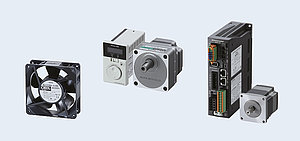What is the delay time for phase A (ASG) pulse output and phase B (BSG) pulse output?
The delay time for phase A pulse output and phase B pulse output for AZ Series, AR Series and NX Series is max. 100 µsec or less.
What is the resolution of the ASG/BSG outputs of the AZ Series?
This depends on the resolution setting of the motor output axis, which is set when the control power supply is switched on. The default setting is 1000 P/R.
How can I check if a brushless motor (BMU Series, BLE2 Series, BXII Series) is broken?
You can check this in a simplified way as follows.
Check that all motor winding resistance values are the same.
1. Ensure that the driver is switched off and disconnect the motor cable from the driver.
2. Place a tester on the pins of the motor cable connector and measure the resistance at three points.
Between blue (U) and purple (V)
Between purple (V) and grey (W)
Between Grey (W) - Blue (U)
If the measured values are all the same resistance value, it is normal.
If the resistance values cannot be measured or if the values differ from each other, burnout or disconnection of the motor is suspected.
Note: If an extension cable is used, first take measurements with the extension cable connected.Then remove the extension cable and measure with the motor cable only.
Check if the driver LEDs light up.
With the motor cable connected, apply power to the driver and check that the display on the control panel and the CHARGE LED* lights up.
If the lights remain off after switching on the power, voltage may not be correctly applied to the power supply line.
Check the power supply voltage with a tester.
If the light remains off even if voltage is correctly applied, a driver failure is suspected.
* The BMU Series does not have a CHARGE LED. Check the display only.
If a product failure is suspected, please use our inspection and repair service (free inspection).
Is the 'Software overtravel' setting information of the AZ Series written to the motor or to the driver?
It is written to the driver.
Therefore, when replacing the driver, the parameter settings must be made again.
Not only the contents of the software overtravel, but also the data settings and parameter settings of the AZ Series are written to the driver. The only content that can be written to the motor is the home position setting by return-to-home operation or P-PRESET input.
When stopping an AZ or AR Series type with an electromagnetic brake during operation, can the motor be stopped by switching off the C-ON input?
Do not use the C-ON input to stop the motor. The reason depends on the model used, as follows.
AZ Series, as well as ARD-A(D), ARD-C(D), ARD-S and ARD-KD*
If the C-ON input is switched OFF during operation, the electromagnetic brake is activated while the motor is running. The excitation is then switched off and the motor drags the electromagnetic brake to a final stop.
The electromagnetic brake is thus designed to engage before the motor excitation is switched off. This is to prevent the workpiece from falling if the C-ON input is switched off when the machine is stopped, by activating the electromagnetic brake first.
This means that the purpose of the electromagnetic brake used in the AZ and AR Series is solely to hold the workpiece in place when the motor is stopped, and is different in construction from a braking electromagnetic brake with brake linings.
Therefore, forcing a motor with inertia to be stopped by friction can put a strain on the brake section, affecting its service life or, in the worst case, damaging it.
ARD-K*
Electromagnetic brakes are externally controlled (e.g. by a programmable controller or other external power source). Therefore, if a control is set up to activate the electromagnetic brake immediately after the C-ON is switched off, the same problem as above can occur.
Alternatively, if the sequence does not activate the electromagnetic brake even after the C-ON is switched off, the motor without holding power will not be able to maintain its position. Especially in the case of vertical drives, the workpiece will fall.
When a workpiece is dropped, the motor becomes a generator and back EMF is applied to the driver.
The back EMF (regenerative voltage) at this time increases with distance and speed, which in some cases may cause an overvoltage alarm in the driver, and in the worst case may damage the driver.
* ARD-...(D) is the AR Series driver name.
During automatic sequencing of the AZ Series, the BREAK-ATSQ input was switched on to manual sequencing. How much time do I then need to take before the SSTART input?
When the BREAK-ATSQ input is switched ON and automatic progressive operation is switched to manual progressive operation:
(1) The motor standstill when the operation data currently in operation is finished.
Motor standstill can be confirmed by the READY output being switched ON.
(2) Once the READY output is switched ON, turn the SSTART input ON for at least 2 msec at the timing output after the simultaneous input (0 sec or more). 2 msec for the SSTART input is the time required for internal processing.
The brushless motor (BMU Series, BLE2 Series, BXII Series) does not rotate. Is there any way to check the cause of non-rotation?
If an alarm has occurred, take action according to the contents of the operating instructions.
If no alarms are present, check the following contents and refer to the relevant sections of the operating instructions.
The product is out of order.
- The motor or driver is faulty.
- The motor cable or extension cable is disconnected.
Wiring problems.
- The power supply is not connected or applied correctly.
- Input signals (FWD, RVS, START, etc.) are incorrectly wired or disconnected.
There is a problem with the parameter settings.
BMU Series:
- The operation method and the "External operation signal" parameter setting are different.
BLE2 Series:
- Operation method and "speed/torque limit command selection" parameter settings differ.
- The torque limit setting is low in relation to the load.
BXII Series:
- The operation method and the 'Analog speed/torque' parameter setting differ.
- The torque limit setting is low for the load.
There is a problem with the state of the input signal or the operating command.
BMU Series:
- Both FWD and RVS inputs are on or both are off.
- The operation switch is in the STAND-BY side.
BLE2 Series:
- Both FWD and RVS inputs are on or both are off.
- Either the START/STOP input or the RUN/BRAKE input is OFF.
- The local operation operation is being used incorrectly.
BXII Series:
- Both FWD and RVS inputs are on or both are off.
- Either the FREE input or the STOP input is ON.
- The S-ON input is assigned to an input terminal, but the S-ON input is OFF.
How to check the input signals
The ON/OFF status of input signals can be monitored on the driver itself for the BMU Series, BLE2 Series and BXII Series. For details, see the operating manual.
In the case of the BLE2 Series, the status can also be monitored by the support software MEXE02.
In the case of the BXII Series, it can also be monitored by the support software MEXE02 and the data setting unit OPX-2A.
The computer went into sleep mode when the AZ Series and the support software MEXE02 were connected. Why does data readout fail when I start up again?
This is because entering sleep mode disconnects the USB.
Unplug and re-plug the USB or re-configure the communication port settings on the MEXE02.
If the problem persists after reconnecting, restart the MEXE02 and read out the data.
The absolute position that can be detected by the AZ series is in the range -900 to +900 revolutions, but will it still work if rotated beyond that range?
It will move even beyond the range of -900 to +900 revolutions without resulting in an alarm. However, if -900 to +900 revolutions are exceeded, the current position counted inside the product will change as follows. The following explanation uses the case of 1000 steps per revolution (factory resolution) as an example.
When exceeding +900 revolutions
+8999999 step is followed by -900000 step
When exceeding -900 revolutions
-900000 step is followed by +8999999 step
The RND-OVF output is switched on when the -900 to +900 rpm range is exceeded. The RND-OVF output is switched off when the power is switched on again.
Note:
- The RND-OVF output only functions when the Round (RND) setting parameter is enabled. When the Round (RND) setting parameter is disabled, the RND-OVF output does not function and will not turn on beyond the -900 to +900 rpm range.
- For AZ14, AZ15, AZ24 and AZ26 types, the absolute position ranges from -450 to +450 rpm.
Is there a limit to the number of times the AZ Series of P-PRESETs can be used?
There is a limit on the number of times. When P-PRESET is executed, it is written to the driver's internal non-volatile memory, so the number of writable cycles is approximately 100 000.
I would like to carry out a 2-3 mm back-and-forth operation with the DR Series, DRS2 Series and DRLII Series, is this a problem in use?
There is no problem with 2-3 mm back-and-forth operation per se.
However, if the drive is a short distance, the grease may not circulate properly and the grease may be blank only in the part being used. Since insufficient grease can lead to failure, please ensure that the grease is circulated by, for example, running the machine at full stroke once a day.
Is there a way to inform that the fan motor has stopped?
Our axial fans are available with a built-in alarm circuit that alerts the user to an abnormality if the fan's blowing capacity is reduced or if the fan stops.
Low speed alarm
An alarm is output when the rotation speed of the fan motor decreases due to life or contamination by foreign matter.
The low rotation can be detected so that arrangements can be made and replaced before the fan motor stops.
Stop sensor
An alarm is output when the fan motor stops.
The fault stoppage can be detected immediately and the relevant fan motor can be replaced.
Is there a way to save energy on equipment by reducing the power consumption of the fans in the control cabinet?
The following methods are effective in reducing the power consumption of fan motors.
Use low-power-consumption fans
Fans equipped with a brushless motor ensure low power consumption.
Use fans with variable speed
The slower the fan speed, the lower the power consumption.
If the air flow is sufficient, variable speed fans can be employed to deliberately reduce the rotation speed.
Are there ways to reduce the noise of axial fans?
Use fans with slow or variable speed.
The slower the fan speed, the lower the noise level.
If the air flow is sufficient, it is effective to use a low-speed type fan in advance.
Another effective method is to deliberately reduce the rotation speed by employing variable speed fans.
I want to use an electric linear slide to position a distance of 300 mm in 1 second. Can I select a product with a maximum speed of 300 mm/s? What should I consider the acceleration/deceleration time?
If you choose the maximum speed as it is, it will actually take longer. The maximum speed in the specification represents the instantaneous top speed of the linear slide and does not take acceleration/deceleration time into account. This means that it will actually take more time.
Although the exact takt time can be determined by calculation, our electric linear slides provide a positioning distance - positioning time diagram for each product for easy confirmation of the takt time.
I use a speed control motor with electromagnetic brake. Is a FREE input (or MB-FREE input) required to run or stop the motor?
The FREE input (or MB-FREE input)* is not required. The FREE input (or MB-FREE input) is a signal to release the electromagnetic brake when the motor is stopped and you want to move the load. To run or stop the motor, use the FWD input or REV input of the operation signal.
* Signal names:
DSC Series: FREE
BLE2 Series: MB-FREE
With electric linear slides, is it possible to mount the sensor on the opposite side to the catalogue's dimensions?
This is possible. For installation, please confirm the product-specific operating manual.
Is it possible to display the position of AZ Series motors in mm on the touch screen?
It can be displayed by using FA network control or Modbus (RTU) RS-485 communication. When FA network control or Modbus (RTU) RS-485 communication is used, the units for command position and feedback position are output in 'step', so please perform the conversion on the touch panel or programmable controller.
Is it possible to change the wiring of the centrifugal blower so that inlet and outlet are reversed?
This is not possible. Changing the wiring does not change the inlet and outlet. The relationship between the air flow in and out is determined not only by the direction of rotation of the runner, but also by the inclination angle of the runner blades, which reduces both air flow and static pressure.
AC axial fans of the MU Series do not have a capacitor, how are they rotated?
By placing a shading coil in the motor winding, it plays the same role as a capacitor in shifting the power supply phase.
We use shaded-pole motors in some of our smaller fans, such as the MU Series.
In the AZ Series built-in controller type, can industrial network control and direct input/output be used together?
Remote I/O and direct I/O via industrial network control or Modbus communication can be used together.
When the same input signals are assigned to remote I/O and direct I/O, the function is executed if either input is present.
The C-ON input* and HMI input** are always ON when not assigned to an input terminal.
When they are assigned to both remote I/O and direct I/O, they will not function unless both are switched ON.
*C-ON input: When switched on, the motor is excitation.
**HMI input : When switched on, the function restrictions of the support software MEXE02 are cancelled.
Can the HOME PRESET switch on the surface of the AZ Series driver be invalidated?
This is possible.
The signal assignment can be changed in the parameter 'Extended input (EXT-IN) function' in the parameter 'EXT-IN & VIR-IN & USR-OUT function (Extend)'.
The initial setting is 'P-PRESET', but if this is changed to "No function", the HOME PRESET switch on the front face of the driver is invalid.
Note that if a signal other than 'P-PRESET' is assigned to this parameter, the HOME PRESET switch can be changed to another function.
Can the programmable controller confirm whether the AZ Series driver accepts the STOP input?
This can be confirmed by the driver's response output.
Take the 'STOP_R' output into the programmable controller.
Whether the motor actually stopped can be confirmed by the 'MOVE' output.
A response output is a signal that outputs the ON/OFF status of the corresponding input signal.
There is a pair of response outputs for all input signals, not just the STOP input (Output signal name: 'Input signal name_R').
Can the AZ Series pulse input type be used with FREE input (motor non-excitation, electromagnetic brake release)?
This is possible. The FREE input operates even when the C-ON input is in the ON state (motor excitation ON).
Can the AZ Series switch to a different number of operation data during positioning mode signal triggered by some signal?
The event jump function enables switching of operation data. The event jump function is a function that causes the operation to be branched according to the ON/OFF of signals set in the 'Event trigger I/O' of the 'Operation I/O event'. If an 'Event trigger I/O' is detected during linked operation or loop operation, the operation is forcibly transitioned to the destination of the combined operation.


